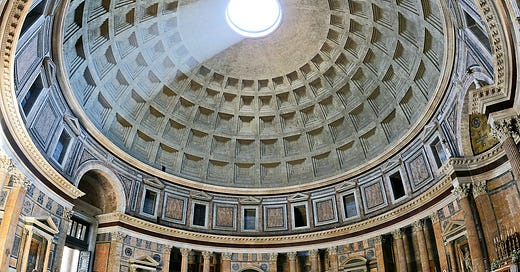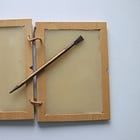Dear Classical Wisdom Kids,
Some ideas from the ancient world have really stood the test of time... and concrete is certainly one of those! (Sorry, I couldn't resist the pun!)
But bad jokes aside, understanding ancient building materials is actually super cool... and will help reinforce (sorry, sorry!) the last video and postcard about the Pantheon.
If you didn’t get a chance to watch and read it, you can do so here:
Postcard from the... Pantheon!
Watch now (40 secs) | Dear friends, I would like to take you on an epic journey around a beautiful site. We are in the city of Rome. We love Rome-ing around Rome. One day we were looking around Rome when …(tan tan tan!) we saw the Pantheon. (The Pantheon is a building with a giant dome in it. It is very pretty.)
Now that you are inspired by what concrete can do... let’s learn how it was made and see if we can ‘make’ some ourselves with today’s craft, below.
All the best,
Anya Leonard
Founder and Director
Classical Wisdom and Classical Wisdom Kids
P.S. If you didn’t already, please take our ONE minute survey and help us out! We want to know from you what you like, what you don’t really need and what you’d like to see more of…
Roman Concrete - A Solid Idea!
Today we look around our cities and towns and we take for granted how big and tall the buildings can be... but how did they get to be that way? Through concrete!
The history of concrete is a fascinating journey through time, showcasing humanity's innovative spirit in building stronger, more durable structures... It actually started with the Egyptians, who mixed lime and gypsum to create a binder for their construction projects, including the pyramids.
But it was the Romans who took this material to a whole other level.
A long, long time ago, in a place called ancient Rome (cue imaginary trumpets), the clever Romans figured out a way to make super strong and durable concrete. Imagine building blocks, but way fancier!
Starting around 300 BC, the Romans needed strong stuff to build their awe-inspiring structures like bridges, aqueducts, and buildings that would stand the test of time.
To do this, the Romans mixed together three ingredients - lime, volcanic ash, and chunks of rock. They called it "opus caementicium," which is just a fancy Latin way of saying "concrete work."
The lime was made by heating limestone, the volcanic ash came from—you guessed it—volcanoes, and the rocks were mixed in to make everything sturdy and tough.
The amazing thing about Roman concrete was that it got stronger over time. As it sat around, soaking up the sun and rain, it would become even tougher - which is why so many amazing Roman buildings have stood the test of time.
One of the most famous examples of Roman concrete in action is the Pantheon in Rome.
This impressive building has a giant dome made with concrete, and it's still standing tall today, almost 2,000 years later. In fact, it is the largest unreinforced (so no metal bars inside) dome in the world!
A couple of cool facts about the Pantheon’s Dome:
The recipe for concrete used at the top of the dome is actually different from the bottom. They choose porous light stones (tufa and pumice), so the roof would not be too heavy.
The design on the inside of the Pantheon not only looks nice, it’s a very clever way to make the ceiling even lighter. These sunken panels, called coffers, mean there is less heavy materials used.
And of course the Oculus itself not only works as a reverse sundial (using light rather than shadow to show the passing of time), it means the very very top of the roof is built out of the lightest stuff possible: air!
So, the next time you see a sturdy bridge or a super old building, remember the Romans and their awesome concrete... Clearly it was a solid idea!
Time to Make Your Own “Fake” Concrete
Okay, okay, so actually making modern concrete can be very cool... and very messy. So if you have older kids and access to the materials, definitely go for it!
Here’s the list of ingredients and steps.
Just remember cement is a fine dust, so kids should wear goggles, gloves, etc to stay safe.
HOWEVER, if you have younger kids and want a fun, much easier simple craft, then I would suggest trying out ‘fake concrete’.
This is what we did. We live in an apartment and actual cement seemed like it would be A LOT more work. This craft, on the other hand, took about 1 minute to set up, was super enjoyable (still messy but easy to clean) and gave me a lot of opportunities to discuss the ideas of cement, building materials, and the properties of solids and liquids while getting our hands dirty.
Fun Fact: This ‘Concrete’ is actually Oobleck, a non-newtonian fluid that acts like a liquid when being poured, but like a solid when a force is acting on it. Sort of like Flubber! It gets its name from the Dr. Seuss book Bartholomew and the Oobleck where a gooey green substance, Oobleck, fell from the sky and wreaked havoc in the kingdom.
Materials:
1.5 cup to 2 cups Cornstarch or Cornflour
1 cup Water
Drops of either food coloring or paint to give it color. We used the former, just in case.
Instructions:
Put the cornstarch in a bowl
Slowly add water while stirring
Add color at the end
Play!
*Note: Since I was doing this craft with just one kid, I actually halved the recipe. There was still PLENTY to play with... If you have a larger group or small kids, I would suggest giving different kids a small amount of water to add until it's the right consistency.
Once you have it, you can try to grab it, make stuff out of it, move it to another vessel... or play music nearby to see the effects!









